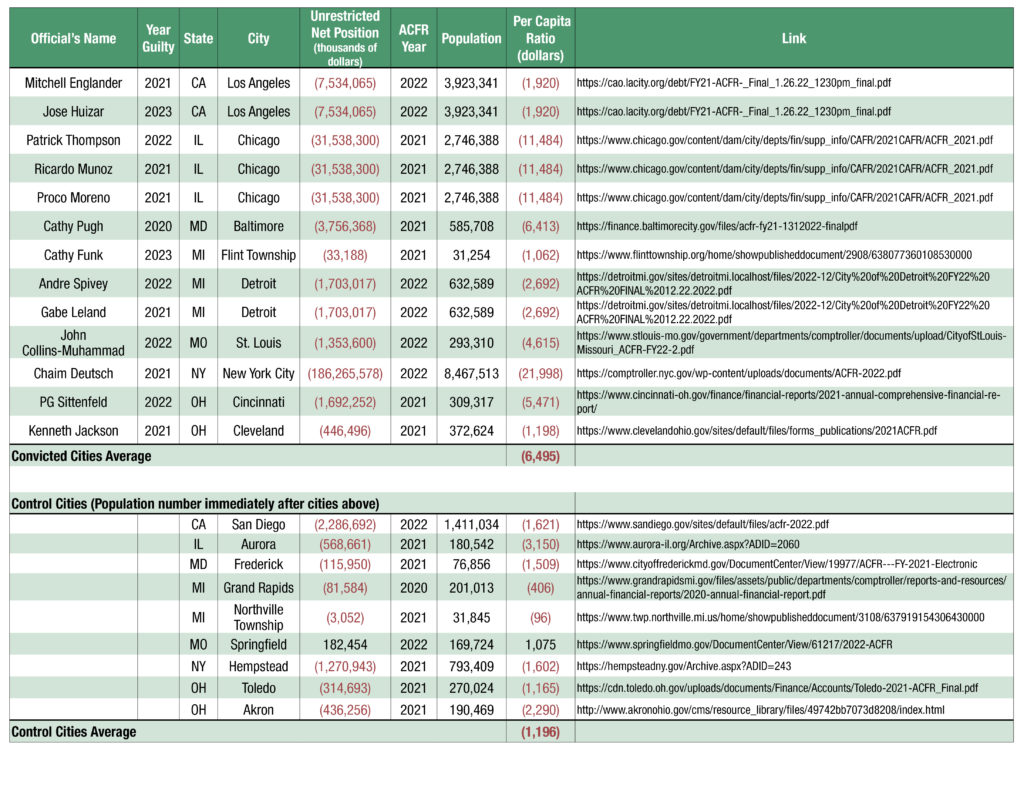Government Size Boosts Corruption
John Seiler | March 10, 2023
Does the size of government reflect the level of corruption? I’ve come up with a way to test that. It involves two variables. First, U.S. city corruption scandals, 2020 to the present, where an official was convicted. Wikipedia lists 12. (I’m including only convicted city officials, not county, state or federal officials.)
The second variable is the city’s unrestricted net position (UNP, deficit or surplus), as shown on its Annual Comprehensive Financial Report, called an ACFR. This is the best number because it shows, if negative, the amount a profligate city has run up debt on the taxpayers’ credit card. The “per capita” number is crucial, because it filters out population size. It’s the amount owed for every person in the city. If it gets too big, debt payments rise and the city risks bankruptcy.
For this, as a “control,” we also need to test cities where no corruption has been listed on the Wikipedia list. The best way to randomize this is to go by city size. For each city with corruption, the “control” city is the next in population size. There are eight of these cities, which then are averaged. The list is smaller because, of the cities with corruption, Chicago is listed three times (no surprise) and L.A. and Detroit twice.
If there’s a correlation between corruption conviction and the shape (positive or negative) of the UNP, then cities with more corruption also will be more profligate – will run up municipal debt higher than cities with no corrupt official on the list.
For the per capita number, the population numbers come from each ACFR. Exceptions: Baltimore’s ACFR lists the latest population number for 2020, which is used. Flint Township didn’t include a population number, so I used Wikipedia’s.
My spreadsheet is below and includes links to the ACFRs. Also, less responsible cities tend to be tardy in reporting their ACFRs, which are prepared by outside, independent accounting firms. I’m using the ACFR closest to the date the politician was found guilty.
For our analysis, the difference is clear, even shocking. For the cities with officials convicted of corruption, the average Unrestricted Net Deficit was ($6,322) per capita. But for the “control” cities, it was just ($1,196) per capita. That’s 5.3 times as much for the cities with convicted officials.
It could be argued the data skew the conclusion toward bias against the large cities. But New York, Chicago and Los Angeles are synonymous with corruption in America. And large cities waste larger amounts of money. They’re always in debt. Detroit even declared bankruptcy in 2013. And although his tenure was before our 2020-present range, Mayor Kwame Kilpatrick resigned in 2008 after a state corruption conviction; then in 2013 was convicted on 24 federal felony counts.
New York City nearly went bankrupt in 1975 until it got federal bailouts of $2.3 billion for three years. When President Ford delayed the federal bribe payment, the New York Daily News headlined, “FORD TO CITY: DROP DEAD.” Felix Rohatyn, an investment banker, became well for known for a time because he headed the Municipal Assistance Corporation that repaired city finances until recently.
I learned the importance of ACFRs and the UNP figure two decades ago from John Moorlach, then Orange County’s treasurer-tax collector; later a supervisor; then a state senator, when I served him as press secretary. “As if it isn’t enough that these individuals floated into office with public employee union money, where there is an inherent level of corruption to begin with,” he told me of the convicted officials. For them to pursue another level of graft above and beyond their beholdeness to those who got them there is brazen. And, based on the reverberations of their actions, resulting in negative UNPs per capita above and beyond the norm, thus making every constituent pay taxes higher and longer, it is unconscionable. Corruption in the public sector hurts everyone’s pocketbook. And in more ways than one.”
Moorlach pointed out the Big Apple’s per-capita UNP today, ($21,998), is almost 10 times as bad as post-bankruptcy Detroit’s ($2,692). “Any more corruption in NYC and it will finally teeter into bankruptcy instead of teetering around the edges. Felix Rohatyn will roll in his grave.”
I have to say that, while doing this research, I was reminded how many of our cities have lost population to massive incompetence and corruption. I was born in Detroit in 1955 when it was called the Paris of the West, population 1.6 million, now 632,589. In 1968 in the World Series, our Tigers beat the the mighty Bob Gibson’s Cardinals of St. Louis, population 600,000, now 293,310.
Although democracy has many virtues, not least being able to “throw the bums out,” its main problem was mocked by H.L. Mencken as an election being “advanced auction of stolen goods.”
It’s axiomatic: What to reduce corruption in government? Then shrink government’s size.
The smaller government is, the fewer opportunities there are for corruption. Big, incompetent government erodes trust and encourages corruption.

